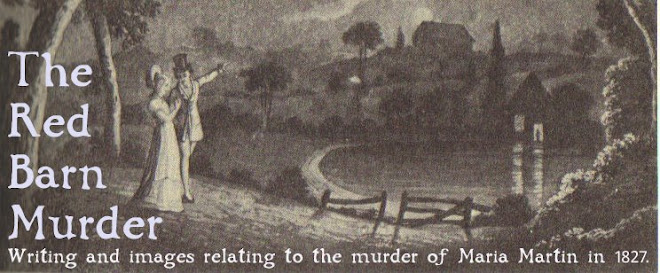The broadsheets that were released during William Corder's trial and after his execution were one way in which people capitalized on the popularity of the murder. One of these, written by James Catnach, supposedly sold over one million copies. The Catnach broadsheet also includes a 'confessional ballad' written, it is asserted, by William Corder himself. It is more than likely that Catnach or an associate wrote the ballad rather than Corder.
 Catnach broadsheet from Wikipedia
Catnach broadsheet from Wikipedia
Adieu adieu, my loving friends my glass is almost run,
On Monday next will be my last when I am to be hang'd.
So all young men who do pass by with pity look on me,
For murdering of that young girl I was hang'd upon a tree.
Versions of this ballad also travelled orally through the 19th century throughout England but as Warren Fahey points out, "Ballads such as The dreadful murder of Maria Marten and the red barn door were sung all over Great Britain and taken to Canada, the USA and Australia." When Australian composer/folk music collector Percy Grainger recorded Joseph Taylor in 1908 at Brigg, Lincolnshire, he sang an abbreviated version of this ballad.
If you'll meet me at the Red Barn
As sure as I have life
I will take you to Ipswich Town
And there make you my wife.
|
|
| This lad went home and fetched his gun,
His pickaxe and his spade.
He went unto the Red Barn
And there he dug her grave.
|
With her heart so light she thought no harm
To meet her love did go.
He murdered her all in the barn
And he laid her body low.
Information on Joseph Taylor can be found here at the (Mostly) English Folk Music website.

Joseph Taylor from the (Mostly) English Folk Music Website
Apparently the melody Taylor sang was derived from the Dives and Lazarus song family. The cylinder recordings Grainger made are available on the album Unto Brigg Fair.
Taylor's version of the ballad can be listened through the EFDSS website (listen here).
The Catnach ballad has also been recorded by Shirley Collins and the Albion Country on their album No Roses. Using the same melody as Taylor it incorporates some very inventive folk rock instrumentation that emphasises the very striking and evocative quality of Shirley Collins' voice on this track.

No Roses by Shirley Collins and the Albion Country Band (from the No Roses website)
Other modern interpretations of the Catnach broadsheet ballad:
Maddie Southorn - The Murder of Maria MartinKathryn Roberts and Sean Lakeman - The Red BarnWhite Swans Black Ravens - Maria Martin
 (from the St. Edmundsbury Borough Council website)
(from the St. Edmundsbury Borough Council website) (from Buried Passions: Maria Martin and the Murder in the Red Barn)
(from Buried Passions: Maria Martin and the Murder in the Red Barn)
 (From - The Red Barn Mystery: Some New Evidence on an Old Murder)
(From - The Red Barn Mystery: Some New Evidence on an Old Murder)






















